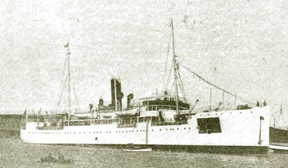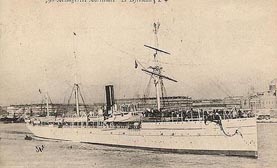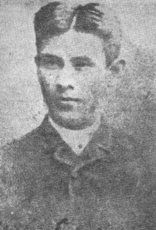Dr. José Rizal's travels.
His first trip to Sunny Spain (1882-1885).
After finishing his fourth year of Medical studies at the University of Santo Tomas, José Rizal was disgusted with the antique method of teaching in the Dominican University. He could no longer stand the racial prejudice of the Dominican professors against the Filipino students. With this in mind he decided to continue his studies in Spain.
May 3, 1882.
José Rizal left secretly the Philippines for Spain. He boarded the Salvadora (right) using a passport as Jose Mercado, which was procured for him by his uncle Antonio Rivera, father of Leonor Rivera. He was accompanied to the quay where the Salvadora was moored by his uncle Antonio, Vicente Gella, and Mateo Evangelista.


9 May 1882.
Rizal arrived at Singapore.


May 11, 1882.
In Singapore, at 2 p.m., Rizal boarded the boat Djemnah (below) to continue his trip to Spain. He found the boat clean and well kept.
May 17, 1882.
Rizal arrived at Punta de Gales.
May 18, 1882.
At 7:30 a.m., he left Punta de Gales for Colombo. In the afternoon, Rizal arrived at Colombo and in the evening the trip was resumed.
May, 27 1882.
He landed at Aden at about 8:30 a.m. He made observation at the time.
June, 2 1882.
He arrived at the Suez Canal en route to Marseilles.
June, 3 1882.
He was quarantined on board the Djemnah in the Suez Canal.
June, 7 1882.
Rizal arrived at Port Said. In a letter to his parents, He described his trip en route to Aden along the Suez Canal.
June, 11 1882.
Rizal disembarked and, accompanied by a guide, went around the City of Naples for one hour. This was the first European ground he set foot on.
June, 12 1882.
At ten o’clock in the evening, the boat anchored at Marseilles. He slept on board.
June, 13 1882.
Early on the morning he landed at Marseilles and boarded at the Hotel Noailles. Later he around for observation.
June, 15 1882.
He left Marseilles for Barcelona in an express train.
June 16, 1882.
At 12:00 noon, Rizal arrived at Barcelona and boarded in the Fonda De España. While he was living in Barcelona he received the sad news about the cholera that was ravaging Manila and the provinces. Many people died. In another letter Paciano advised his younger brother to finish his medical studies in Madrid.
October 2, 1882.
Rizal enrolled himself in the Universidad Central of Madrid – Medicine and Philosophy and Letters. Beside those studies he also studied painting and sculpture in the Academy of Fine Arts of San Fernando and took French, German and English lessons under private instructors. He also practiced fencing and shooting.
April 1883.
Rizal became a Mason, he joined the Masonic lodge called Acacia in Madrid. He was impressed by the way the Spanish openly and freely criticized the government policies and lambasted the friars, this could absolute not be done in the Philippines. He became a Mason to secure the Freemasonry's aid in his fight against the friars in the Philippines. Later he transferred to Lodge Solidaridad (Madrid) where he became a Master Mason on November 15, 1890.
June 17 to August 20, 1883.
He visited Paris for the first time. He first stayed in Hotel de Paris on rue de Maubeuge, later on he moved to a cheaper hotel, 124, Rue de Rennes in the Quartier Latin. Like all other tourists the attractive sights of Paris charmed Rizal. He was often mistaken for a Japanese by the Parisians. While staying in Paris he observed different diseases of women in the Lariboisière Hospital under Dr. Nicaise. In a letter home he commented Paris is the costliest capital in Europe.
June 21, 1884.
Rizal completed his medical course in Spain. He obtained the degree of Licentiate in Medicine by the Universidad Central de Madrid. The next academic year (1884-85) he studied and passed all subject leading to the degree of Doctor of Medicine. But due to the fact that he did not present the thesis required for graduation nor paid the corresponding fees, he was not awarded the Doctor's Degree.
After completing his studies in Madrid,
Rizal went to Paris and Germany in order to specialize in ophthalmology (1885-1887).
November 1885 to February 1886.
He sojourned for four months in Paris working as an assistant under Dr. Louis de Wecker, the leading French ophthalmologist. He rapidly improved his knowledge of ophthalmology.
Trip around Europe (1886-1887).
February 1, 1886.
He left Paris for Germany. He visited Strasbourg.
February 3,1886.
He arrived in Heidelberg, an historic German city famous for its old University. Towards the end of April 1886 Dr. Rizal moved to Wilhelmsfeld on the invitation of Karl Ullmer, a Protestant pastor. On June 25 he ended his vacation and returned to Heidelberg. On July 31, 1886 he wrote his first letter in German to Professor Blumentritt. On August 9, 1886 he left Heidelberg and made a River Rhine trip, went to Frankfurt and proceeded to Leipzig. On October 29 he left Leipzig and went to Dresden.
November 1, 1886.
Dr. Rizal left Dresden by train and reached Berlin in the Evening.



February 21, 1887.
His first novel "Noli me Tangere" was finally ready and in March 1887 it came of the press. After the publication of the Noli me Tangere he left Berlin together with Dr. Maximo Viola (1st left) on a roaming spree. They started a Grand Tour of Europe.
May 11, 1887.
They left Berlin by train heading for Dresden.
May 13, 1887.
This was a very special day for Dr. Rizal, he would meet Professor Blumentritt (2nd left) at 1.30 pm at the train station Leitmeritz, Bohemia. They stayed in Leitmeritz from May 13 to May 16. After leaving Leitmeritz they went to Brno.
May 20, 1887.
They proceeded to the beautiful city of Vienna, at that time the capital of Austria-Hungary. They visited the city for a couple of days and left on May 24 for a boat trip on the River Danube to Linz.
From Linz they travelled by train to Salzburg and proceeded to Munich. The next train trip was to Nuremberg, one of the oldest cities of Germany. They continued to Ulm, the cathedral of this city was the largest and tallest of Germany. From Ulm they proceeded to Stuttgart. And from here they transferred to Switzerland where they visited the Rheinfall cascades, Schaffhausen, Basel, and Bern. From Bern they went to Lausanne where they took a boat to Geneva on Lake Leman.
June 2 to 4, 1887.
They went on to Basel, Bern and Lausanne. After sightseeing in Lausanne Dr. Rizal and Dr. Viola took a little steamer sailing on Lake Leman and they disembarked at Geneva on 6 June 1887. On June 19, 1887 Rizal invited Viola for his 26th Birthday. They spend 15 days in Geneva.
June 23, 1887.
Dr. Viola left for Barcelona and Dr. Rizal continued his tour to Italy.
In Italy Dr. Rizal he visited Turin, Milan, Venice and Florence.
June 27, 1887.
Dr. Rizal reached Rome, the "Eternal City" and also called the "City of the Caesars". He was thrilled by the sights and memories of the Eternal City. He wrote to Prof. Blumentritt about the "grandeur that was Rome".
June 29, 1887.
On the Feast Day of St. Peter and of St. Paul, Dr. Rizal visited the Vatican, the "City of the Popes", the capital of Christendom. He was profoundly impressed by what he saw. Every night he returned to his hotel, very tired. After passing a week in Rome, he prepared to return to the Philippines. He had already informed his father of his homecoming.
First Homecoming (1887-1888).
Rizal left Rome by train for Marseilles. On July 3, 1887, he boarded the steamer Djemnah, the same steamer on which he came to Europe five years ago. The steamer was on route for the Orient via the Suez Canal, Rizal saw this historic canal for the second time. On July 30,1887 he transferred to another steamer, the Haiphong which had Manila as destination at Saigon.
August 5, 1887.
The voyage from Saigon to Manila was a pleasant one. He arrived in Manila near midnight. Rizal went ashore as a happy man, he finally reached his beloved fatherland. For a short time he stayed in the city to visit his friends. He found Manila to be the same as he left it five years ago. The same buildings, the same old churches, the same boats on the Pasig river ..


August 8, 1887.
He returned to Calamba. His family welcomed him with tears of joy. But they were also very worried about his safety. Paciano didn't leave him out of sight the first days after his arrival home. In Calamba, Dr. Rizal established a Clinic. While Rizal was living peacefully in Calamba a storm raised over the Noli. A few weeks later Dr. Rizal received a letter from the Governor General Emilio Terrero (1885-1888) requesting him to come to Malacañan Palace. Rizal went to Manila and appeared before the Governor General. Someone informed the Governor General that the Noli contained Subversive ideas. Rizal denied the charges he was accused of, he explained that he merely tried to reveal the truth. Pleased with the explanation the Governor General asked the author for a copy so he could read it.
José Rizal went to visit the Jesuit fathers to ask them for a copy of his book. The Jesuits told him "everything in it was the truth but they added "you may lose your head for it". Since the Jesuits would not give them their copy of the book Rizal had to look for one at another friend. Fortunately he found one and gave it to the Governor General. As promised he read the book and found nothing wrong with it. But Rizal's enemies were very powerful and the Governor General knew Rizal's life was in jeopardy and he assigned a young Spanish lieutenant, Don Jose de Taviel de Andrade, as his bodyguard. The two became close friends and the lieutenant became a great admirer of Dr. Rizal.
After Calamba's Agrarian Trouble and Rizal's exposure of the deplorable conditions of the tenancy in Calamba infuriated further his enemies. The friars exerted pressure on the Malacañan Palace to eliminate him. They asked to deport him and the Governor General refused. Later on the Governor General "advised" Rizal for his and his families safety to leave the country. So Dr. José Rizal leaves the Philippines for the second time.
Second Trip to Europe (1888- )
February 3, 1888.
After a short stay of six months in his beloved Calamba Dr. Rizal left Manila for Hong Kong on board of the Zafiro.
February 8, 1888.
Arrival in Hong Kong. During his stay in Hong Kong he sojourned in Victoria Hotel. He was welcomed by the Filipino residents but the Spanish authorities had someone spying on him while he was staying in the British Colony.
Accompanied by Dr. Jose Ma. Basa Dr. Rizal visited Macao. They boarded the ferry-steamer Kiu-Kiang for Macao. Macao was a Portuguese colony near Hong Kong. During his two days visit he visited the Theatre, the casino, the Cathedral and churches, ... on February 19 he witnessed a Catholic procession.
February 20, 1888.
Dr. Rizal and Basa returned to Hong Kong on the same ferry-steamer Kiu-Kiang. During his two week stay he mainly studies the Chinese life, language, drama and customs.
February 22, 1888.
Dr. Rizal left Hong Kong on board of the steamer Oceanic, an American steamer. His destination was Japan.
February 28, 1888.
Dr. Rizal arrived in Yokohama. He registerd in the Grand Hotel.
February 29, 1888.
He left Yokohama for Tokyo. He registered in the Tokyo Hotel. He wrote to Prof. Blumentritt "Tokyo is more expensive than Paris". Shortly after his arrival in Tokyo he was contacted by the secretary of the Spanish Legation. The latter invited him to stay at the Spanish Legation instead of the Hotel. Dr. Rizal was well aware that the diplomatic authorities were instructed from Manila to follow his every move. He accepted the invitation.
March 7, 1888.
Dr. Rizal checked out of the Tokyo Hotel and lived at the Spanish Legation. He was embarrassed not to speak the Japanese language. He looked like a Japanese but could not speak Japanese. In Tokyo very few people spoke English, so Rizal had a very difficult time. People looked at him as being ill-educated, Children laughed with him.
To avoid further embarrassment Rizal decided to start studying Japanese. While staying in Tokyo Dr. Rizal met O-Sei-San, a lovely girl (See His Love Life) who helped him with understanding and learning Nippongo (Japanese language).
April 13, 1888.
Sayonara Japan. He boarded the Belgic, an English steamer bound for the United States.
April 28, 1888.
Rizal saw for the first time the United States. the boat docked at San Francisco. Not all passengers were allowed to land. The American authorities quarantined the ship on the ground that it came from the far east and that there was an cholera epidemic. Rizal knowing that this was not true he joined up with the other passengers to protest. Rizal discovered that the quarantine was only a cover and that in fact it was purely political, There were Chinese Coolies on board. After a week of quarantine all first class passengers were allowed to land.
May 4, 1888.
The day he was allowed to land he registered at the Palace Hotel, a first class hotel in the city. Rizal stayed in San Francisco for two days.
May 6, 1888.
Rizal left San Francisco for Oakland, across San Francisco Bay by ferry boat. In Oakland he boarded the train for his trip across the country.
May 13, 1888.
Dr. Rizal reached New York in the morning. He stayed three days in the city he called "the big town".
May 16, 1888.
He left New York for Liverpool on board of the City of Rome. According to Rizal this steamer was the second largest ship in the world. The largest being the Great Eastern.
Rizal had good and bad impressions about America, but the bad one was the lack of racial equality. There existed racial prejudice which was inconsistent with the principles of democracy and freedom of which the Americans talk so much but do not practice.
May 24, 1888.
Dr. Rizal arrived in Liverpool. He stayed for one day at teh Adelphi Hotel from where he wrote to his family : "Liverpool is a big and beautiful city and its celebrated port is worthy of its great fame. The entrance is magnificent and the customhouse is quite good".
May 25, 1888.
From Liverpool Dr. Rizal travelled to London. For a brief period he was the guest of Dr. Antonio Ma. Regidor>, an exile of 1872 and a practising lawyer in London. By the end of May he found an affordable an modest boarding house at No. 37 Chalcot Crescent, Primrose Hill He was a boarder of the Beckett Family, the Becketts, Mr & Mrs Beckett had two sons and four daughters. The oldest daughter was Gertrude or "Gettie" or "Tottie" by her friends.
The Becketts home was near to public parks and within walking distence to the British Museum where he spend many hours poring over the pages of Morga's Sucesos and other rare works about the Philippines. Dr. Rizal, while staying in London, he met Dr. Reinhold Rost, a librarian of the Ministry of Foreign Affairs. He was an autority on Malayan languages and custums. Dr. Rost was impressed by Dr. Rizal and gladly recommended him to the authorities of the British Museum. He called Dr. Rizal "a pearl of a man".
Dr. Rizal spend most of his time in the Britisch Museum reading Morga's Sucesos and other rare historical works about the Philippines. Toghether with Dr. Regidor he discussed about Phillipine Affairs.
On Sunday he often played cricket with the sons of Dr. Rost and had many pleasant discussions on linguistics with the Dr.
Good and bad news from home reached Dr. Rizal while he was staying in London. The bad new that reached him was about the injustices committed by the Spanish authorities on the Filipino people and the Rizal Family. The persecution of the Filipino patriots who signed the "Anit-Friar Petition of 1888"
